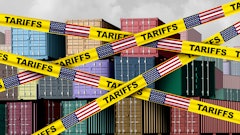
Los Angeles/Long Beach (LA/LB) import volumes remain strong following the Lunar New Year, and there are signs that the trucking capacity-to-demand ratio may soon start pushing rates up for dray and rail capacity. In addition, equipment availability for exports is still an issue affecting individual ocean carrier lines throughout North America.
“Should rates begin to increase, this may affect truckers’ ability to honor dedicated pricing and tender acceptance in Q2,” says Paul Brashier, VP, global supply chain for ITS Logistics. “It could be alleviated as more volumes return to the U.S. East & Gulf Coasts, now that labor strikes are no longer a concern. With the return of volumes back to the U.S. East & Gulf Coasts, there has been a tightening of capacity and terminal congestion at the major gateways of New York/New Jersey, Norfolk, Savannah, and Houston.”
Key takeaways:
- On March 11, the International Longshoremen’s Association (ILA) signed an extension to its Master Contract with the United States Maritime Alliance (USMX). This agreement is set to last until Sept. 30, 2030, and includes workforce protection guidelines that require a detailed explanation of the technology that will be used and its effects on capacity and efficiency. The agreement also requires determination on the manning for new equipment to be included with stipulations that new work created by the technology be identified with training included for workers.
- Despite this new agreement, the supply chain continues to experience challenges, including the current equipment availability concerning exporters, which has been a lingering concern thus far in 2025.
- As concerns over labor strikes ease, import volumes have begun redistributing from the West back to East and Gulf Coast ports. However, the United States Trade Representative’s (USTR) recent proposal targeting Chinese vessels threatens to disrupt U.S. port operations once again. Announced in late January, the proposal includes fees targeting Chinese vessel operators, Chinese-built vessels, and operators with a certain percentage of vessels ordered from Chinese shipyards. Research from the World Shipping Council (WSC) found that the proposal could add up to $3.5 million in fees per individual port call to 98% of vessels entering the U.S. The WSC notes that ocean carriers have already indicated they may eliminate service to smaller ports to avoid these costs—a move that would severely impact regional logistics ecosystems and exacerbate congestion at major North American ports.
“This latest supply chain challenge in equipment availability that ITS is closely monitoring is driven primarily by equipment imbalance and rail operations,” says Brashier. “Rail operations are seeing similar sporadic challenges regionally. LA/Long Beach IPI dwell remains high for imports moving east. That, combined with rail transit delay and lower inland transportation costs, are pushing some shippers to move imports back to the ports on the East Coast and draying inland to avoid IPI legs.”



![Pros To Know 2026 [color]](https://img.sdcexec.com/mindful/acbm/workspaces/default/uploads/2025/08/prostoknow-2026-color.mduFvhpgMk.png?auto=format%2Ccompress&bg=fff&fill-color=fff&fit=fill&h=100&q=70&w=100)







![Pros To Know 2026 [color]](https://img.sdcexec.com/mindful/acbm/workspaces/default/uploads/2025/08/prostoknow-2026-color.mduFvhpgMk.png?ar=16%3A9&auto=format%2Ccompress&bg=fff&fill-color=fff&fit=fill&h=135&q=70&w=240)








